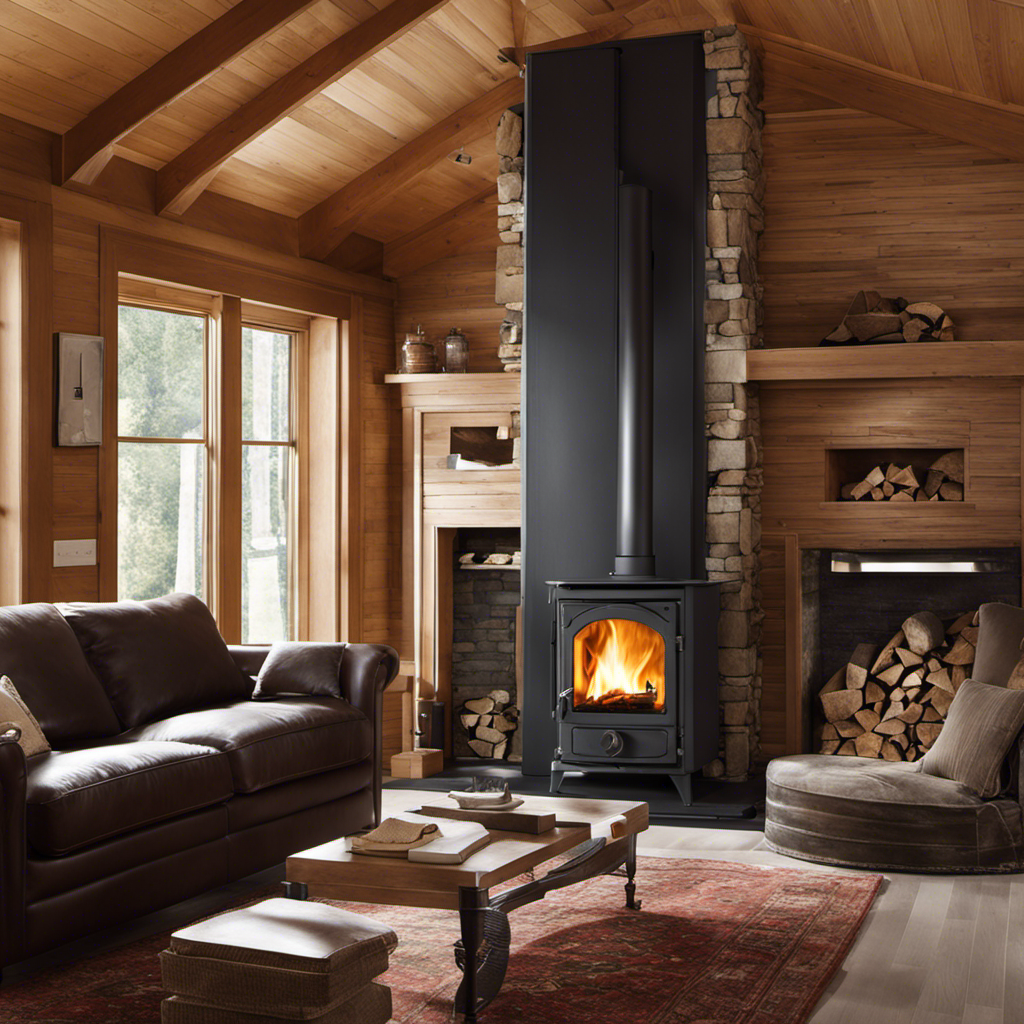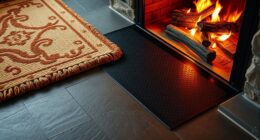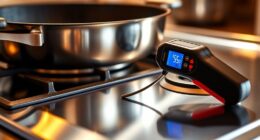I’m here to guide you through the process of safely installing your wood stove, ensuring it meets all safety standards.
With my detailed knowledge and expertise, I’ll help you understand the importance of proper location, venting requirements, clearances, and floor protection.
I’ll also emphasize the significance of regular maintenance and carbon monoxide safety.
By following these guidelines, you’ll be able to operate your wood stove safely and in compliance with local building codes and regulations.
Let’s get started on creating a warm and secure environment in your home.
Key Takeaways
- Follow manufacturer’s guidelines and consult NFPA and local building codes for proper wood stove installation.
- Choose a certified installer who is knowledgeable about local regulations and has a good track record.
- Select a suitable location with proper clearances, ventilation, and proximity to exits.
- Install a chimney that meets safety requirements, including proper height, insulation, and sealing.
Understanding Safety Standards for Wood Stoves
I need to understand the safety standards for wood stoves before installing one. It’s crucial to prioritize safety when it comes to wood stove maintenance and installation. By adhering to safety precautions, we can prevent potential accidents or hazards.
When it comes to safety standards for wood stoves, there are several key factors to consider.
Firstly, it’s essential to ensure proper installation. This involves following the manufacturer’s guidelines and utilizing a certified professional if needed. The installation process should include sufficient clearance from combustible materials, such as walls or furniture, to minimize the risk of fire.
Regular maintenance is another vital aspect of wood stove safety. Cleaning the stove and chimney on a regular basis prevents the buildup of creosote, a highly flammable substance that can lead to chimney fires. It’s also important to inspect the stove for any signs of wear or damage and replace any faulty parts immediately.
Additionally, practicing safe operation is crucial. This includes using the appropriate fuel, such as seasoned wood, and never overloading the stove. Proper ventilation and the use of a carbon monoxide detector are also essential to protect against the risk of carbon monoxide poisoning.
Understanding and adhering to safety standards for wood stoves is paramount to ensure the safety of both your home and your family. By following the recommended maintenance and safety precautions, you can enjoy the warmth and comfort of a wood stove with peace of mind.
Choosing the Right Location for Your Wood Stove
When selecting a spot for my wood stove, it’s important to consider the ideal location.
Not only do I need to ensure proper ventilation requirements for my wood stove, but I also want to minimize the risk of burns and accidents with proper location selection.
Ventilation requirements are crucial for ensuring proper airflow for my wood stove. I need to make sure that there’s enough fresh air coming into the room to support combustion and prevent the buildup of dangerous gases. This can be achieved by having a dedicated air intake or ensuring that there’s enough natural ventilation in the room.
Safety precautions are also essential in choosing the right location for my wood stove. I need to keep it away from combustible materials such as curtains, furniture, and walls. It should also be placed on a non-combustible surface like a tile or stone hearth to prevent any fire hazards. Additionally, I need to consider the proximity of the stove to exits in case of an emergency.
By considering all these factors, I can select the ideal location for my wood stove that ensures proper ventilation and minimizes the risk of accidents.
Now, let’s move on to the next important aspect of safe installation – venting and chimney requirements.
Venting and Chimney Requirements for Safe Installation
To properly vent my wood stove, it’s important to have a chimney that meets the necessary requirements for safe operation. Venting requirements are crucial to ensure the efficient and safe operation of a wood stove. The chimney installation plays a vital role in removing the byproducts of combustion, such as smoke and gases, from your home.
When it comes to chimney installation, there are several factors to consider. First, the chimney height should be sufficient to create proper draft and prevent smoke from entering your living space. The table below provides a visual representation of the recommended chimney heights based on the distance between the stove and the top of the chimney.
| Stove-to-Chimney Distance | Minimum Chimney Height |
|---|---|
| Up to 10 feet | 12 feet |
| 10-20 feet | 15 feet |
| Over 20 feet | 20 feet |
Additionally, the chimney should be insulated to prevent excessive heat transfer to combustible materials and reduce the risk of chimney fires. It’s also important to ensure that the chimney is properly sealed to prevent any leaks or drafts.
Proper Clearances: Keeping Your Wood Stove Away From Combustible Materials
Proper clearances are essential for keeping my wood stove a safe distance away from combustible materials. When it comes to fire prevention and safety precautions, ensuring adequate space between my wood stove and any flammable objects is crucial. The National Fire Protection Association (NFPA) and local building codes set specific guidelines for these clearances to minimize the risk of fire accidents.
The required clearance distances vary depending on the type of material and the specific stove model. Generally, combustible materials such as walls, furniture, curtains, and rugs should be kept a minimum distance of 36 inches away from the stove. However, it’s important to consult the manufacturer’s instructions and local regulations for precise measurements.
To maintain these clearances, I regularly inspect the area around my wood stove for any potential hazards. I ensure that there are no flammable materials within the specified distance and that the surrounding walls and floors are in good condition. Additionally, I keep a fire extinguisher nearby and test it regularly to ensure it’s in proper working order.
Floor Protection: Ensuring Safe Installation of Your Wood Stove
I make sure to place a non-combustible floor protector underneath my wood stove to prevent any damage or accidents. Floor protection is a crucial aspect of ensuring the safe installation of a wood stove. It serves as a barrier between the stove and the floor, preventing heat transfer and potential fire hazards. When choosing a floor protector, it is important to select materials that are fireproof and able to withstand high temperatures.
To illustrate the importance of floor protection, I have created a table below that compares different types of fireproof materials commonly used for this purpose:
| Material | Description |
|---|---|
| Ceramic Tile | Durable and resistant to heat, scratches, and spills. It provides excellent protection against fire damage. |
| Sheet Metal | Sturdy and able to withstand high temperatures. However, it may need additional insulation for better safety. |
| Brick | A traditional option that offers good fire resistance. It can be aesthetically pleasing but requires proper installation. |
| Concrete | Provides excellent protection against heat and fire. It is durable, but it may crack over time. |
| Hearth Pad | Specifically designed for wood stoves, it is made of fireproof materials and offers maximum protection. |
Installing a Fireproof Wall Shield for Added Safety
Adding a fireproof wall shield enhances the safety of my wood stove setup. One option is to create a DIY wall shield using materials such as sheet metal, cement board, or fire-resistant tiles. These materials can provide an additional layer of protection against heat and sparks. However, it’s important to ensure that the shield is installed correctly and securely to prevent any gaps or loose fittings that could compromise its effectiveness.
Another option is to hire a professional to install a fireproof wall shield. Professionals have the knowledge and expertise to properly install a wall shield that meets safety standards. They can assess the specific needs of my wood stove setup and recommend the most suitable materials and design for the wall shield. Additionally, professional installation ensures that the wall shield is securely attached to the wall, eliminating the risk of it falling or shifting over time.
When deciding between DIY and professional installation, it’s essential to consider factors such as my level of experience, budget, and the complexity of the installation. While DIY installation may be more cost-effective, professional installation provides peace of mind knowing that the wall shield is properly installed and meets safety standards.
Ultimately, the choice between DIY and professional installation will depend on my comfort level and preference for ensuring the safety of my wood stove setup.
Insulating Your Chimney to Prevent Heat Transfer and Fire Hazards
Insulating my chimney is crucial for preventing heat transfer and reducing the risk of fire hazards. Proper insulation can help maintain a safe and efficient wood stove installation.
When it comes to insulating techniques, there are a few options to consider. One common method is using an insulating blanket or wrap, which is designed to create a barrier between the hot flue gases and the surrounding materials. This can help prevent heat loss and reduce the risk of fire spreading to nearby combustible materials.
Another technique is applying insulation directly to the interior walls of the chimney. This can be done using a special insulation mix or by installing a pre-insulated chimney liner. Both methods help to minimize heat transfer and maintain a safe temperature within the chimney.
Insulating my chimney not only helps prevent heat transfer but also addresses common chimney problems. One of these problems is the formation of condensation. Cold air outside can cause the warm flue gases to cool rapidly, leading to condensation forming on the inside of the chimney. This moisture can damage the chimney structure over time.
By insulating the chimney, the temperature inside is maintained, minimizing the formation of condensation and protecting the chimney from potential damage.
Properly Installing and Sealing Stovepipe Connections
When properly installed and sealed, stovepipe connections create a secure and efficient pathway for the exhaust gases to exit the wood stove. This is crucial for the safe operation of your wood stove and the prevention of any potential hazards.
Here are three reasons why proper installation and sealing of stovepipe connections are essential:
-
Safety: Ensuring the stovepipe connections are properly installed and sealed reduces the risk of carbon monoxide leaks. Carbon monoxide is a colorless and odorless gas that can be deadly if inhaled in high concentrations. By maintaining a secure connection, you can have peace of mind knowing that your wood stove is operating safely.
-
Efficiency: Properly installed and sealed stovepipe connections allow for better airflow and combustion in the wood stove. This results in improved heat transfer to your living space and helps to maximize the efficiency of your wood stove. With efficient operation, you can enjoy a warm and cozy home while minimizing fuel consumption.
-
Easy maintenance: When stovepipe connections are installed correctly, they’re easier to access for regular chimney cleaning and maintenance. Proper insulation ensures that the connections remain secure and in good condition, making it easier to remove any creosote buildup or debris that may accumulate over time.
The Importance of Regular Maintenance for Safe Wood Stove Operation
Regular maintenance is essential for the safe operation of my wood stove. As a responsible homeowner, I understand the importance of keeping my wood stove in top condition to prevent any potential hazards. By conducting regular maintenance, I can ensure that my wood stove operates efficiently and safely, providing warmth and comfort for my home.
To emphasize the significance of regular maintenance, let me present a table that highlights the potential risks associated with neglecting this essential task:
| Neglected Maintenance | Risks |
|---|---|
| Failing to clean the chimney regularly | Increased risk of chimney fires |
| Ignoring damaged or worn out components | Potential for carbon monoxide leaks |
| Neglecting to inspect the stove’s exterior | Risk of overheating and damage to surrounding materials |
| Forgetting to clean the ash pan and firebox | Reduced efficiency and increased risk of fire |
| Ignoring the need for professional inspections | Missed opportunities to identify potential issues and address them proactively |
By understanding these risks, it becomes clear that regular maintenance is crucial for ensuring the safe operation of my wood stove. Taking the time to clean and inspect my stove on a regular basis not only promotes its longevity but also safeguards the well-being of my household.
Carbon Monoxide Safety: Installing and Testing Detectors
I need to make sure that I’ve carbon monoxide detectors properly installed and regularly tested in my home. Carbon monoxide is a dangerous gas that’s odorless and colorless, making it impossible to detect without the help of detectors. The consequences of carbon monoxide poisoning can be severe, leading to symptoms such as headache, dizziness, nausea, and in extreme cases, even death.
Here are three reasons why it’s crucial to have carbon monoxide detectors in your home:
-
Peace of mind: Having carbon monoxide detectors installed in your home provides peace of mind, knowing that you’ll be alerted in case of any potential carbon monoxide leaks. This gives you the confidence to sleep soundly at night, knowing that you and your family are safe.
-
Early detection: Carbon monoxide detectors are designed to detect even the smallest traces of the gas. By having them properly installed and regularly tested, you can ensure that any leaks or malfunctions are detected promptly. Early detection is key in preventing carbon monoxide poisoning and preserving your health.
-
Importance of proper ventilation: Carbon monoxide is often produced by fuel-burning appliances such as furnaces, fireplaces, and stoves. Proper ventilation is essential in ensuring that the gas is safely expelled from your home. Having carbon monoxide detectors serves as a reminder to regularly check and maintain the ventilation systems in your home, ensuring that they’re functioning properly.
Fire Safety Tips for Operating Your Wood Stove Safely
Having a working smoke detector is crucial for ensuring the safety of my home when operating a wood stove. In addition to having a reliable smoke detector, there are other important fire safety tips to keep in mind when using a wood stove.
One of the key aspects of fire safety is proper firewood storage. It’s important to store firewood at least 30 feet away from the house, as it can easily ignite and cause a fire if stored too close. Also, firewood should be stored off the ground to prevent moisture and pests from damaging it.
Another important fire safety tip is proper ash disposal. Ashes should be completely cooled before disposing of them in a metal container with a tight-fitting lid. This helps to prevent any remaining embers from reigniting and causing a fire. It’s also important to keep the container outside and away from any flammable materials.
To summarize, fire safety when operating a wood stove involves having a working smoke detector, proper firewood storage, and proper ash disposal. By following these guidelines, I can ensure the safety of my home and prevent any potential fire hazards.
Understanding Local Building Codes and Regulations for Wood Stove Installation
Understanding and complying with local building codes and regulations is essential when installing a wood stove in my home. Not only does it ensure the safety of my family and property, but it also helps me avoid potential legal issues and fines. Here are three crucial things to consider when it comes to local building codes and regulations for wood stove installation:
-
Understanding local permits: Before installing a wood stove, I need to research and understand the local permits required. This may involve obtaining a permit from the municipality or notifying the local fire department. By following the proper permit process, I can ensure that my wood stove installation is compliant with local regulations.
-
Researching wood stove brands: It’s important to choose a wood stove brand that meets the safety standards set by local building codes. By researching reputable brands and their compliance with safety regulations, I can select a wood stove that’s reliable and approved for installation in my area.
-
Finding a certified installer: To ensure proper installation and compliance with local building codes, it’s crucial to find a certified installer. A certified installer will have the necessary expertise and knowledge to install the wood stove safely and in accordance with local regulations.
Frequently Asked Questions
Are There Any Specific Requirements for the Size or Type of Wood Stove That Can Be Installed?
There are specific requirements for the size and type of wood stove that can be installed.
The size of the wood stove should be appropriate for the space it will be installed in, ensuring that it fits properly and doesn’t pose a fire hazard.
The type of wood stove should also meet safety standards, including proper ventilation and clearances from combustible materials.
It’s important to consult with a professional to ensure a safe and compliant installation.
What Are the Recommended Clearances for a Wood Stove From Combustible Materials?
Clearance recommendations are an essential aspect of fire safety precautions when installing a wood stove. It’s crucial to maintain proper distances between the stove and combustible materials to prevent potential fire hazards.
Following the recommended clearances ensures that there’s enough space for air circulation and reduces the risk of accidental fires. Adhering to these guidelines is vital for the safe and effective installation of a wood stove in your home.
How Often Should the Stovepipe Connections Be Inspected and Sealed?
Inspecting and sealing stovepipe connections is crucial for maintaining a safe wood stove. Regular maintenance ensures that there are no leaks or gaps that could lead to smoke or carbon monoxide entering your home.
I recommend inspecting and sealing these connections at least once a year to prevent any potential hazards. By taking the time to properly maintain your stovepipe and chimney, you can enjoy the warmth and comfort of your wood stove with peace of mind.
How Do I Properly Insulate My Chimney to Prevent Heat Transfer and Fire Hazards?
To properly insulate my chimney and prevent heat transfer and fire hazards, I need to take certain measures.
Firstly, I should use an insulating material, such as ceramic fiber insulation or vermiculite insulation, to line the interior of the chimney. This will help reduce heat loss and prevent the surrounding combustible materials from catching fire.
Additionally, I should ensure that the chimney is properly sealed at all joints and connections to prevent any heat leakage or potential fire hazards.
Regular inspections and maintenance are crucial to ensure the insulation remains effective.
What Are the Regulations Regarding Carbon Monoxide Detectors for Wood Stove Installations?
When it comes to wood stove installations, it’s important to understand the regulations surrounding carbon monoxide detectors. Many people have misconceptions about these detectors, but they play a crucial role in keeping your home safe.
Regular maintenance for wood stoves is also vital to ensure they’re functioning properly and not emitting dangerous levels of carbon monoxide.
Understanding these regulations and taking the necessary precautions will help ensure the safety of your wood stove installation.
Conclusion
So there you have it, folks. Making sure your wood stove meets safety standards is just a bunch of boring regulations and guidelines that you have to follow.
Who needs that? Just throw your stove wherever you want, don’t worry about venting or clearances, and forget about maintenance or carbon monoxide detectors.
It’s not like those things are important for your safety or anything. Who needs a house that doesn’t burn down, right?
Ignorance is bliss!





